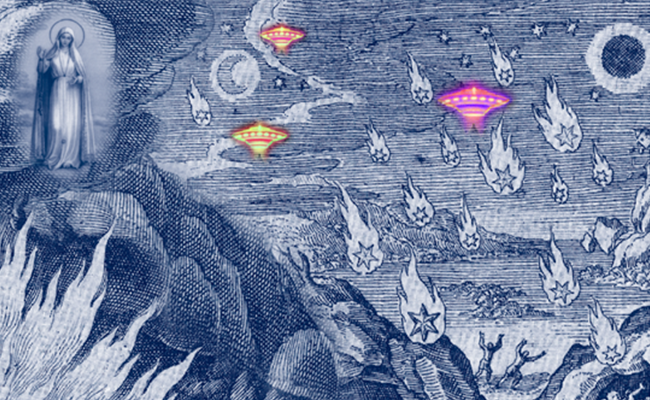Tuesday 7 February 2023 4:23pm

This image is used to advertise the paper. Dr Elizabeth Guthrie says it is a collage which is, in part, based on an engraving of the four Horsemen of the Apocalypse by Merian Matthaus the Elder (1593 - 1650). Matthaus was a Swiss artist who lived and worked in Frankfurt. Dr Guthrie added in the spaceships.
New Religious Movements is one of the more intriguing papers on offer at the University of Otago over the summer.
Nineteen people are taking this year’s summer course, most online, says RELS214/306 lecturer Dr Elizabeth Guthrie.
Some are students of religious studies, theology and/or anthropology, but some students have never studied religion, and are taking the paper out of curiosity, Dr Guthrie says.
One student took the paper in an attempt to make sense of childhood experiences growing up in a cult in New Zealand.
The paper covers the history, membership and main features of a number of religious movements: ISKCON, Goenka’s Vipassana movements, the Falun Gong, Rastafarianism, Nation of Islam, Marian Cold War Apocalypticism, the Branch Davidians in Waco Texas, and UFO “spaceship cults”.
Dr Guthrie says determining whether religion is “new” or not depends both on context and self-definition.
“All religions were ‘new’ once. Often, new religious movements emerge from older traditions. So, you can have a new religious movement within Buddhism, Hinduism, Christianity, or Islam.”
For example, ISKCON (the Hare Krishnas) traces its origins to India more than 5000 years ago. But it became what it is today when the Indian guru, Sri La Prabhupada, travelled to New York in the 1960s and started to convert young college drop-outs experimenting with the counter-culture of the time.
Many people are quite anxious about possible connections between cults, brainwashing and the potential for violence. However, most scholars believe that while new religious movements often challenge mainstream society, experimenting with religious beliefs is something that young, educated people — especially those who are ‘seekers’ — may go through.
“Joining a cult is almost like a rite of passage, a lifecycle ritual, an opportunity to experiment with difference and step outside one’s own culture,” Dr Guthrie says.
Scholars have found the retention rate for converts to new religious movements is low, less than 5%. So even though a group may claim to have made thousands of converts, after a few years most have moved on.
The work of the famous 1920s German sociologist Max Weber is important for the paper. Weber defined charisma as an extraordinary power that certain individuals have. But Weber argued that charisma is inherently unstable.
“Inevitably, charismatic leaders will make a mistake, or die. Some disillusioned followers will drift away, and the movement will experience crisis.” Dr Guthrie says.
The remaining faithful try to resolve crisis in different ways. One way is by institutionalising the new religious movement.
Attempts may be made to transmit charisma to a new individual by inheritance, election or by ritual, and to establish an orthodox canon. Another strategy is re-writing the group’s history. Most new religious movements engage in the progressive reinterpretation of reality or “myth-making”.
Probably the biggest change in new religious movements today is the internet: a lot of preaching and conversion happens online, and different groups are linked despite geographical distances.
-Kōrero by internal communications adviser, Koren Allpress